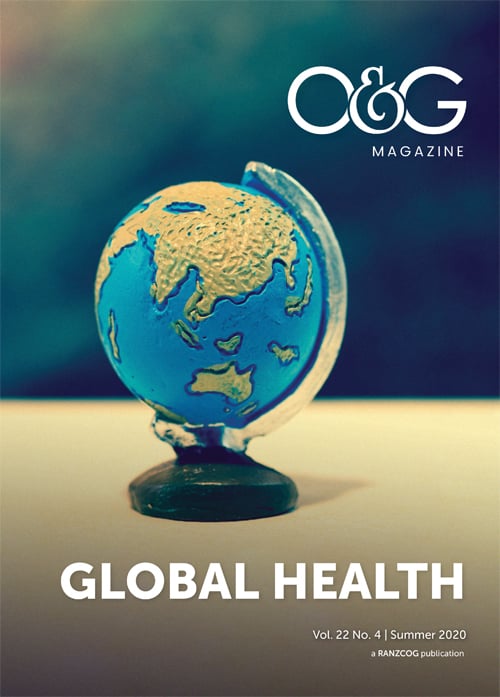The events of 2020 have cast global health into the spotlight. Extreme weather events, worldwide protests against systemic racism and a global pandemic have brought into sharp focus that global challenges can only be tackled through collective and collaborative efforts.
– Global Health Council
This issue of O&G Magazine features a number of in-depth discussions on ongoing global health challenges, such as, ensuring all women receive respectful maternity care and recognising maternal health as a priority especially during COVID-19. Several articles also highlight how we can do global health better, such as, PEMNet and ONE-Sim, demonstrating the benefits of collaborative training. Stories like the remarkable 35-year-old (and counting) relationship between the Pacific Society of Reproductive Health (PSRH) and RANZCOG illustrate the collective power of working together to improve reproductive health in our region.
In the last 20 years, droughts, floods and bushfires have increased exponentially, with over 7000 extreme weather events recorded globally.1 These environmental disasters have led to the loss of lives and livelihoods, land and wildlife. The Australian bushfires of 2019–20 burned 17 million hectares of land across NSW, Victoria, Queensland, ACT, Western Australia and South Australia, and over one billion animals were estimated to have perished in Victoria and NSW alone.2
The smoke from the Australian bushfires was so bad that, for multiple days, parts of Australia recorded the worst air quality in the world.3 For pregnant women, exposure to bushfire smoke can cause respiratory complications, including breathing difficulties and coughing. Babies born to smoke-affected mothers have an increased risk of being small-for-gestational age and preterm,4 as well as an increased incidence of respiratory infections and wheeze in childhood.5 Maternity care providers in Albury, an area that was particularly smoke-affected during the bushfires earlier this year, have anecdotally noted an increase in fetal growth restriction, retained placenta and premature births.6
Australia and New Zealand (NZ) are often heralded as being some of the safest countries in the world to give birth, yet mainstream maternity systems based on traditional medical models continue to fail to meet the needs and values of Aboriginal, Torres Strait Islander, Māori and Pasifika women.7 8 This is reflected in the substantially poorer perinatal outcomes that Aboriginal, Torres Strait Islander, Māori and Pasifika women continue to face. Between 2012–17, the maternal mortality ratio for Aboriginal and Torres Strait Islander women was 26.5 per 100,000 births, over four times higher than the ratio for non-Indigenous women (6 per 100,000).9 In NZ, Māori women are overrepresented in maternal suicide rates. Between 2006–2016, approximately 60% of women who died by suicide in pregnancy or within six weeks of pregnancy were Māori women.10 Culturally unsafe practices within maternity systems are a key barrier to accessing appropriate care,11 and poor perinatal outcomes are higher among women who have encountered racism.12 13
It has been estimated that cervical cancer may be eliminated from Australia as a public health issue in the next 20 years.14 The significant reduction in cervical cancer in Australia is the result of political commitments to national screening programs and the roll out of the HPV vaccination initiative. However, these gains have not been equal, with Aboriginal and Torres Strait Islander women still disproportionately affected by cervical cancer,15 and in much of Africa, for example, cervical cancer remains the leading cause of cancer-related death in women.16
We cannot talk about global health without mentioning COVID-19. At the time of writing, the COVID-19 pandemic has seen over 41 million cases of COVID-19 and almost 1.2 million deaths globally.17 Descriptions of COVID-19 as the ‘great leveller’18 and a ‘virus which does not discriminate’19 are simply incorrect. Individuals and communities which persistently lack social, economic or political power have been most affected by COVID-19. Higher rates of COVID-19 have been associated with insecure employment, income inequality, overcrowded living conditions and poor access to social support and health resources. In low- and middle-income countries, reproductive, maternal, newborn, child and adolescent health services have been severely disrupted leading to increased maternal and newborn deaths, less access to contraception, more unplanned pregnancies, and less immunisation services. It is estimated that over a six-month period, the pandemic may result in an additional 1,157,000 child and 56,700 maternal deaths.20
COVID-19 has exacerbated existing cracks in health systems and brought gender issues to the forefront. Women make up 70% of the frontline health workforce worldwide and generally have a higher level of carer responsibilities. The economic impacts from COVID-19 have been compounded for women who generally earn less, are more likely to have insecure employment, work part-time and carry the bulk of unpaid care work, which has increased with childcare and school closures.21 Social and economic stressors, restricted movements and isolation have also seen a substantial rise in gender-based violence. A survey of 15,000 Australian women found that 4.6% of women – 8.8% of women in a relationship – had experienced physical or sexual violence from a current or former cohabiting partner between February and May 2020.22 For a third of these women, it was the first time they had experienced physical or sexual violence in their relationship.
The events of 2020 have not only presented global health challenges, they have presented political ones. Politics is intimately linked to healthcare. For our field of work, political issues which involve sexual, reproductive, maternal, child and adolescent healthcare are especially in ‘our lane’. Health care providers have long fought for women’s health issues and policy change. In Australia and NZ, providers of women’s healthcare, including RANZCOG, have been key advocates for abortion reform driving improvements in abortion service access, delivery, clinician training and campaigning for safe access zones around abortion clinics.
Healthcare providers can play an important part in building and supporting societal, economic and policy reforms to improve social conditions and counter health inequities. We can take individual and collective actions to ensure laws affecting human lives are informed by evidence-based policy.23 Firstly, we can vote and vote with purpose. Your vote is your voice and your voice counts. Secondly, we can lobby our local representatives, write letters to the editor and opinion pieces, join advocacy groups and work with dedicated community-based organisations. Lastly and perhaps most importantly, speak out against implicit and systematic discrimination against race, gender, age, marital status, sexual orientation or expression, disability, and religious or political beliefs. Global maternal and newborn health challenges are challenges for us all. Social and political reforms are critical, and we all have a role to play.
– Lowitja O’Donoghue
References
- United Nations. The human cost of disasters: an overview of the last 20 years (2000-2019). New York, USA: United Nations 2020.
- Parliament of Australia. 2019–20 Australian bushfires—frequently asked questions: a quick guide Canberra, Australia: Parliament of Australia; 2020. Available from: www.aph.gov.au/About_Parliament/Parliamentary_Departments/Parliamentary_Library/pubs/rp/rp1920/Quick_Guides/AustralianBushfires.
- Borchers Arriagada N, Palmer AJ, Bowman DM, et al. Unprecedented smoke-related health burden associated with the 2019–20 bushfires in eastern Australia. MJA. 2020;213(6):282-3.
- Abdo M, Ward I, O’Dell K, et al. Impact of Wildfire Smoke on Adverse Pregnancy Outcomes in Colorado, 2007–2015. International Journal of Environmental Research and Public Health. 2019;16(19):3720.
- Willis GA, Chappell K, Williams S, et al. Respiratory and atopic conditions in children two to four years after the 2014 Hazelwood coalmine fire. MJA. 2020;213(6):269-75.
- Mackee N. Harms from bushfire smoke: “yesterday was the time to talk about it”. MJA Insight. Australia: MJA, 2020. Available from: https://insightplus.mja.com.au/2020/37/harms-from-bushfire-smoke-yesterday-was-the-time-to-talk-about-it.
- Dennis FM, Keedle H. Birthing As Country. Women and Birth. 2019;32(5):383-90.
- Harris R, Robson B, Curtis E, Purdie G, Cormack D, Reid P. Māori and non-Māori differences in caesarean section rates: a national review. N Z Med J. 2007;120(1250):U2444.
- Australian Institute of Health & Welfare. Mothers and Babies Canberra, Australia: Australian Institute of Health & Welfare 2018. Available from: www.aihw.gov.au/reports/mothers-babies/australias-mothers-and-babies-2018-in-brief/contents/table-of-contents.
- Twelfth Annual Report of the Perinatal and Maternal Mortality Review Committee: Reporting mortality 2016.Wellington: Health Quality & Safety Commission.
- Brown AE, Fereday JA, Middleton PF, et al. Aboriginal and Torres Strait Islander women’s experiences accessing standard hospital care for birth in South Australia–A phenomenological study. Women and Birth. 2016;29(4):350-8.
- Brown SJ, Gartland D, Weetra D, et al. Health care experiences and birth outcomes: Results of an Aboriginal birth cohort. Women and Birth. 2019;32(5):404-11.
- Thayer Z, Bécares L, Atatoa Carr P. Maternal experiences of ethnic discrimination and subsequent birth outcomes in Aotearoa New Zealand. BMC Public Health. 2019;19(1):1271.
- Hall MT, Simms KT, Lew J-B, et al. The projected timeframe until cervical cancer elimination in Australia: a modelling study. Lancet Public Health. 2019;4(1):e19-e27.
- Diaz A, Baade PD, Valery PC, et al. Comorbidity and cervical cancer survival of Indigenous and non-Indigenous Australian women: A semi-national registry-based cohort study (2003-2012). PloS one. 2018;13(5):e0196764.
- Arbyn M, Weiderpass E, Bruni L, et al. Estimates of incidence and mortality of cervical cancer in 2018: a worldwide analysis. Lancet Global Health. 2020;8(2):e191-e203.
- Johns Hopkins Corona Virus Resource Centre. COVID-19 Dashboard: Johns Hopkins; 2020. Available from: https://coronavirus.jhu.edu/map.html.
- Clark A. This great leveller will end, but the world will be different. Australian Financial Review 2020. Available from: www.afr.com/politics/federal/this-great-leveller-will-end-but-the-world-will-be-different-20200408-p54i55
- United Nations. COVID-19 does not discriminate; nor should our response. Geneva, Switzerland: UNHCR; 2020. Available from: www.ohchr.org/EN/NewsEvents/Pages/DisplayNews.aspx?NewsID=25730&LangID=E.
- Roberton T, Carter ED, Chou VB, et al. Early estimates of the indirect effects of the COVID-19 pandemic on maternal and child mortality in low-income and middle-income countries: a modelling study. Lancet Global Health. 2020;8(7):E901-8.
- United Nations. Policy Brief: The Impact of COVID-19 on Women New York, USA: United Nations 2020.
- Boxall H, Morgan, A, Brown, R. The prevalence of domestic violence among women during the COVID-19 pandemic. Canberra, Australia: Australian Institute of Criminology, 2020. PMMRC. 2018.
- Berwick DM. The Moral Determinants of Health. JAMA. 2020;324(3):225-6.






Leave a Reply